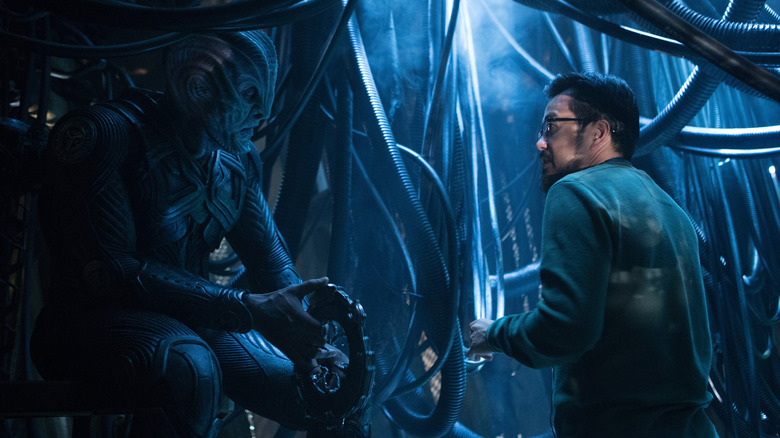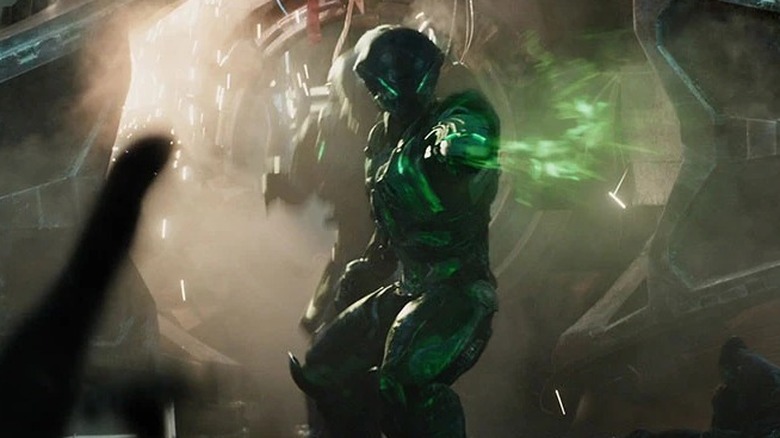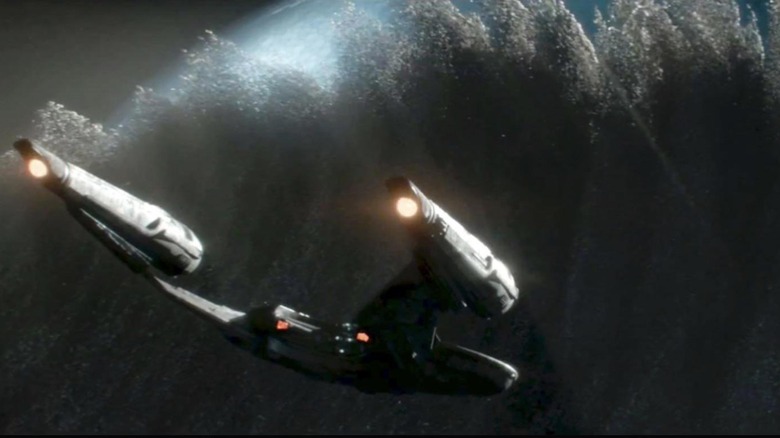Star Trek Beyond Had A Deeper Backstory For Krall's Army That Fans Never Got To See
"Star Trek Beyond" might be the best "Mass Effect" movie we ever get. The shiny Yorktown station, with city sprawls built along the surface of spinning, gravity-manipulating rings, is a dead ringer for the Citadel. The film's villain — Krall (Idris Elba) — leads an army of robots, "The Swarm," much like Saren Arterius employing the cyclopean robot Geth in the first "Mass Effect."
Krall's army destroys the Enterprise in the first act of "Beyond," leaving the crew stranded on planet Altamid. Though Krall made his home on this world, he isn't a native. No, he's really Balthazar Edison, once the (human) captain of the Starfleet ship the U.S.S. Franklin. After the Franklin crashed on Altamid in the 22nd century, rescue from the Federation never came and Edison became disillusioned.
He and his surviving crew found abandoned technology, including his Swarm army (originally invented as "sophisticated mining equipment," not disposable soldiers) and the life-draining devices they've sustained himself with. (Krall's alien appearance was siphoned from his victims with said tech.) When the Swarm destroys the Enterprise, they do so by ramming it repeatedly, not blasting it out of the sky with phasers. Such a physical approach makes sense if the ships were designed to mine a planet's surface.
According to "Star Trek Beyond" co-writer Doug Jung, the team originally had some "loftier ambitions" for the backstory of Krall's army.
The Swarm in Star Trek Beyond
In a 2016 interview with TrekCore, Jung elaborated on these plans while offering insight into how the Swarm functions: "Justin's idea was that [the Swarm soldiers] were sort of like drones in a way and that they don't actually have a lot conscious thought of their own. That sort of answers how Krall would be able to come in and take all this stuff." That's also why, in the film's climax, the Enterprise bridge crew disrupts the Swarm with a signal playing the Beastie Boy's "Sabotage." The Swarm has command signals, not thoughts, and is a hive mind more easily felled than the Borg.
Speaking to CinemaBlend, Jung confirmed the idea of the Swarm was "Star Trek Beyond" director Justin Lin's: "[Lin] liked that idea of like asymmetrical warfare and he kind of made sense. He's like, 'Why would you have that big ship going around? Why not just get a bunch of little ones?'"
As for how Edison took control of the Swarm and perverted them, turning them from harmless miners into vicious attack dogs, Jung explained: "[Edison] was taking his skills as an ex-soldier and applying them in a way that he probably never thought he would have to do."
This backstory is briefly alluded to in "Star Trek Beyond," where Kirk (Chris Pine) and Scotty (Simon Pegg, who also co-wrote the movie) find Edison's final captain's log aboard the Franklin, where he mentions that the "indigenous race" of Altamid "left behind sophisticated mining equipment and a drone workforce." In his TrekCore interview, Jung also refers to Altamid as an abandoned "mining colony." This helps explain why the Swarm's creators abandoned it; it was never their home.
A Star Trek to remember
This exposition is enough to put the pieces together about where the Swarm came from and how Edison/Krall became their leader, at least for attentive viewers. (Some fans seem to have missed it, and came out of the movie questioning where Krall got an army from, or not realizing that the Swarm were the mining drones Edison mentioned in his log, not armored aliens). Any of Jung's "loftier ambitions" for the Swarm may have ended up in the 30 minutes that Lin had to cut from "Star Trek: Beyond" (per Collider), just like a scene expanding on Sulu's (John Cho) role.
A resounding praise for "Star Trek Beyond" is that it feels like an episode of "Star Trek: The Original Series," just two hours long and with modern effects. The backstory of Altamid is part of that. Critic Darren Mooney, reviewing episode "The Gamester of Triskelion," noted:
"The episode presents a planet that is a graveyard, occupied by ruins of an ancient civilization that collapsed in on itself long before mankind reached the stars. It recalls the eerie sense that space is a graveyard, an element of early stories like 'The Cage' or 'Charlie X' or 'The Man Trap' or 'What Are Little Girls Made Of?' or even 'The Squire of Gothos.'"
An abandoned planet home to a legion of androids, seized upon by a human driven insane on the edges of space? That's classic "Star Trek."


